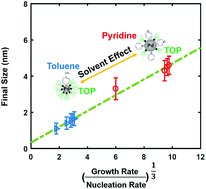Colloidal nanoparticle size control: experimental and kinetic modeling investigation of the ligand–metal binding role in controlling the nucleation and growth kinetics†
Abstract
Despite the major advancements in colloidal metal nanoparticles synthesis, a quantitative mechanistic treatment of the ligand's role in controlling their size remains elusive. We report a methodology that combines in situ small angle X-ray scattering (SAXS) and kinetic modeling to quantitatively capture the role of ligand–metal binding (with the metal precursor and the nanoparticle surface) in controlling the synthesis kinetics. We demonstrate that accurate extraction of the kinetic rate constants requires using both, the size and number of particles obtained from in situ SAXS to decouple the contributions of particle nucleation and growth to the total metal reduction. Using Pd acetate and trioctylphosphine in different solvents, our results reveal that the binding of ligands with both the metal precursor and nanoparticle surface play a key role in controlling the rates of nucleation and growth and consequently the final size. We show that the solvent can affect the metal–ligand binding and consequently ligand coverage on the nanoparticles surface which has a strong effect on the growth rate and final size (1.4 nm in toluene and 4.3 nm in pyridine). The proposed kinetic model quantitatively predicts the effects of varying the metal concentration and ligand/metal ratio on nanoparticle size for our work and literature reports. More importantly, we demonstrate that the final size is exclusively determined by the nucleation and growth kinetics at early times and not how they change with time. Specifically, the nanoparticle size in this work and many literature reports can be predicted using a single, model independent kinetic descriptor, (growth-to-nucleation rate ratio)1/3, despite the different metals and synthetic conditions. The proposed model and kinetic descriptor could serve as powerful tools for the design of colloidal nanoparticles with specific sizes.



 Please wait while we load your content...
Please wait while we load your content...